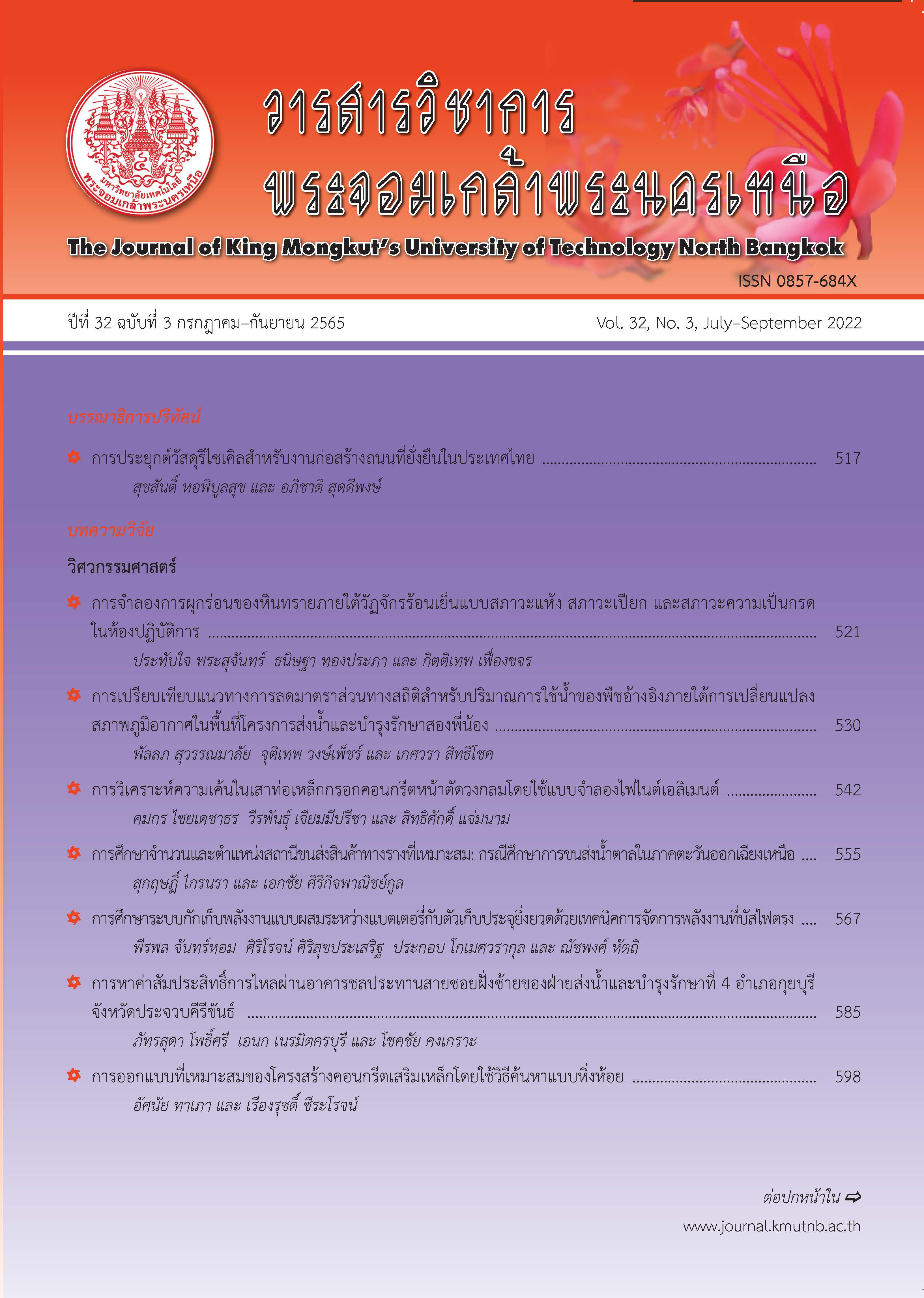กำลังยึดเหนี่ยวของเหล็กข้ออ้อยในคอนกรีตเมื่อใช้เถ้าลอยจีโอพอลิเมอร์มอร์ตาร์ผสมเอฟจีดียิปซั่มเป็นวัสดุยึดเกาะ
Main Article Content
บทคัดย่อ
งานวิจัยนี้มีจุดประสงค์เพื่อพัฒนาการใช้เถ้าลอยแคลเซียมสูงจีโอพอลิเมอร์มอร์ต้าร์ผสมเอฟจีดียิปซั่มเป็นวัสดุยึดเกาะระหว่างเหล็กเสริมกับคอนกรีต งานวิจัยนี้ใช้คอนกรีตที่ออกแบบกำลังอัดประลัยที่อายุการบ่ม 28 วัน เท่ากับ 25 เมกะปาสคาล และจีโอพอลิเมอร์มอร์ต้าร์จากเถ้าลอยแคลเซียมสูงผสมเอฟจีดียิปซั่มร้อยละ 0, 10, 20 และ 30 โดยน้ำหนักวัสดุประสาน โดยปฏิกิริยาของจีโอพอลิเมอร์มอร์ต้าร์ถูกกระตุ้นด้วยสารละลายโซเดียมซิลิเกตและสารละลายโซเดียมไฮดรอกไซด์ที่ความเข้มข้น 10 โมลาร์ และแปรผันปัจจัยของอัตราส่วนสารละลายโซเดียมซิลิเกตต่อสารละลายโซเดียมไฮดรอกไซด์ต่อกำลังยึดเหนี่ยวของเหล็กข้ออ้อยในคอนกรีต สำหรับการเตรียมตัวอย่างคอนกรีต คอนกรีตสดถูกเทลงแบบหล่อทรงลูกบาศก์ขนาด 100x100x100 มิลลิเมตร หลังจากนั้นตัวอย่างคอนกรีตถูกถอดแบบและห่อด้วยพลาสติกทันทีและเก็บไว้ที่ห้องควบคุมอุณหภูมิ (25 2 องศาเซลเซียส) จบครบ 28 วัน หลังจากนั้นตัวอย่างคอนกรีตถูกเจาะรูตรงกลางตัวอย่างคอนกรีตให้มีขนาดเท่ากับ 22 มิลลิเมตร และดำเนินการติดตั้งเหล็กข้ออ้อยขนาด 12 มิลลิเมตรและใช้จีโอพอลิเมอร์มอร์ต้าร์เป็นวัสดุเชื่อมประสาน โดยกำลังยึดเหนี่ยวของเหล็กข้ออ้อยในคอนกรีตถูกทดสอบที่อายุการบ่มเท่ากับ 7 วัน ผลการทดสอบ พบว่า กำลังยึดเหนี่ยวของเหล็กข้ออ้อยในคอนกรีตที่มีการใช้เถ้าลอยแคลเซียมสูงจีโอพอลิเมอร์มอร์ต้าร์แทนที่ด้วยเอฟจีดียิปซั่มมีแนวโน้มลดลงเล็กน้อย ขณะที่ปริมาณของอัตราส่วนสารละลายโซเดียมซิลิเกตต่อสารละลายโซเดียมไฮดรอกไซด์ที่เพิ่มขึ้นช่วยพัฒนากำลังยึดเหนี่ยวได้ยกเว้นส่วนผสมของการแทนที่เอฟจีดียิปซั่มร้อยละ 30 และกระตุ้นด้วยอัตราส่วนสารละลายโซเดียมซิลิเกตต่อสารละลายโซเดียมไฮดรอกไซด์เท่ากับ 2.5 จากผลการทดสอบข้างต้นแสดงให้เห็นว่า การทำปฏิกิริยาระหว่างแคลเซียมซัลเฟตจากเอฟจีดี ยิปซั่มกับซิลิกาที่มีความว่องไวต่อการทำปฏิกิริยาจากสารละลายโซเดียมซิลิเกตส่งผลต่อกำลังยึดเหนี่ยวของเหล็กข้ออ้อยในคอนกรีตอย่างมีนัยสำคัญ เมื่อพิจารณาเปรียบเทียบกับกำลังยึดเหนี่ยวของคอนกรีตควบคุม พบว่า กำลังยึดเหนี่ยวที่มีการใช้เถ้าลอยแคลเซียมสูงจีโอพอลิเมอร์มอร์ต้าร์ผสมเอฟจีดียิปซั่มเป็นวัสดุยึดเกาะมีค่าสูงกว่าคอนกรีตควบคุม จากผลการวิเคราะห์ข้างต้นสามารถสรุปได้ว่า เถ้าลอยแคลเซียมสูงจีโอพอลิเมอร์มอร์ต้าร์ผสมเอฟจีดียิปซั่มสามารถพัฒนาเป็นวัสดุเชื่อมประสานระหว่างเหล็กเส้นและคอนกรีตได้
Article Details

อนุญาตภายใต้เงื่อนไข Creative Commons Attribution-NonCommercial-NoDerivatives 4.0 International License.
บทความที่ลงตีพิมพ์เป็นข้อคิดเห็นของผู้เขียนเท่านั้น
ผู้เขียนจะต้องเป็นผู้รับผิดชอบต่อผลทางกฎหมายใดๆ ที่อาจเกิดขึ้นจากบทความนั้น
เอกสารอ้างอิง
Y. Suansane, “Visual inspection of concrete cracks in MRT Ratchadapisek,” M.CE. thesis, School of Construction and Infrastructure Management, Suranaree University of Technology, 2017 (in Thai).
D. Intarabut, H. Sodrum, T. Ongloy, T. Phoo-ngernkham, S. Punjanta, A. Pattarawongpaibol, and R. Sahamitmongkol, “Pull-out capacity of anchor in geopolymer concrete,” presented at the 23th National Convention on Civil Engineering, Nakhon Nayok, Thailand, July 18–20, 2017 (in Thai).
D. Intarabut, H. Sodrum, T. Ongloy, B. Injorhor, and T. Phoo-ngernkham, “Innovative bonding agent of steel bars in concrete made from high calcium fly ash geopolymer mortar containing hybrid cement,” presented at the 23th National Convention on Civil Engineering, Nakhon Nayok, Thailand, July 18–20, 2017 (in Thai).
Building Code Requirment for Structure Concrete Practice (ACI 318-08) and Commentary, ACI 318, 2008.
S. Songpiriyakij, T. Pulngern, P. Pungpremtrakul, and C. Jaturapitakkul, “Anchorage of steel bars in concrete by geopolymer paste,” Materials and Design, vol. 32, no. 5, pp. 3021–3028, 2011.
K. Chompoovong, T. Phoo-ngernkham, S. Detphan, C. Detphan, S. Hanjitsuwan, and P. Chindaprasirt, “Effect of portland cement content on compressive strength and elastic modulus of high-calcium fly ash geopolymer mortar containing various type of alkali solution,” The Journal of KMUTNB, vol. 30, no. 4, 2020 (in Thai).
K. Chompoovong, T. Phoo-ngernkham, S. Detphan, C. Detphan, S. Hanjitsuwan, and P. Chindaprasirt, “Properties of pervious geopolymer concrete made from high-calcium fly ash containing calcium carbide residue,” The Journal of KMUTNB, vol. 30, no. 2, 280–290, 2020 (in Thai).
C. Detphan, T. Phoo-ngernkham, S. Detphan, K. Chompoovong, S. Hanjitsuwan, and P. Chindaprasirt, “Factors of FGD-gypsum replacement and alkaline solution ratio on compressive strength and microstructure of fly ash geopolymer,” The Journal of KMUTNB, vol. 31, no. 4, 2021 (in Thai).
C. Detphan, S. Detphan, K. Chompoovong, T. Phoo-ngernkham, S. Hanjitsuwan, and P. Chindaprasirt, “Mechanical properties of highcalcium fly ash geopolymer with nano-SiO2 particle sizes,” The Journal of KMUTNB, vol. 31, no. 1, 2021 (in Thai).
P. Chindaprasirt, P. De Silva, K. Sagoe-Crenstil, and S. Hanjitsuwan, “Effect of SiO2 and Al2O3 on the setting and hardening of high calcium fly ash-based geopolymer systems,” Journal of Materials Science, vol. 47, no. 12, pp. 4876–4883, 2012.
X. Guo, H. Shi, L. Chen, and W. A. Dick, “Alkaliactivated complex binders from class C fly ash and Ca-containing admixtures,” Journal of Hazardous Materials, vol. 173, no. 1–3, pp. 480–486, 2010.
S. Hanjitsuwan, T. Phoo-ngernkham, and N. Damrongwiriyanupap, “Comparative study using Portland cement and calcium carbide residue as a promoter in bottom ash geopolymer mortar,” Construction and Building Materials, vol. 133, pp. 128–134, 2017.
S. Hanjitsuwan, T. Phoo-ngernkham, L. Y. Li, N. Damrongwiriyanupap, and P. Chindaprasirt, “Strength development and durability of alkaliactivated fly ash mortar with calcium carbide residue as additive,” Construction and Building Materials, vol. 162, pp. 714–723, 2018.
S. Hanjitsuwan, B. Injorhor, T. Phoo-ngernkham, N. Damrongwiriyanupap, L.Y. Li, P. Sukontasukkul, and P. Chindaprasirt, “Drying shrinkage, strength and microstructure of alkali-activated highcalcium fly ash using FGD-gypsum and dolomite as expansive additive,” Cement and Concrete Composites, 2020.
Y. C. Liang, Z. M. Ye, F. Vernerey, and Y. Xi, “Development of processing methods to improve strength of concrete with 100% recycled coarse aggregate,” Journal of Materials in Civil Engineering, vol. 27, no. 5, pp. 04014163, 2015.
V. Sata, A. Wongsa, and P. Chindaprasirt, “Properties of pervious geopolymer concrete using recycled aggregates,” Construction and Building Materials, vol. 42, pp. 33–39, 2013.
T. Phoo-ngernkham, C. Phiangphimai, D. Intarabut, S. Hanjitsuwan, N. Damrongwiriyanupap, L.Y. Li, and P. Chindaprasirt, “Low cost and sustainable repair material made from alkali-activated highcalcium fly ash with calcium carbide residue,” Construction and Building Materials, vol. 247, pp. 118543, 2020.
Standard Specification for Concrete Aggregate, ASTM C33-03, 2003.
Standard Specification for Rail-steel and Axlesteel Deformed Bars for Concrete Reinforcement. ASTM A996/A996M-16, 2016.
T. Phoo-ngernkham, V. Sata, S. Hanjitsuwan, C. Ridtirud, S. Hatanaka, and P. Chindaprasirt, “High calcium fly ash geopolymer mortarcontaining portland cement for use as repair material,” Construction and Building Materials, vol. 98, pp. 482–488, 2015.
Standard Practice for Selecting Proportions for Normal, Heavyweight, and Mass Concrete, ACI 211.1-91, 1991.
Standard Test Method for Comparin g Concreteson the Basis of the Bond Developed with Reinforcing Steel, ASTM C234-91, 1991.
Standard Test Methods for Strength of Anchors in Concrete Elements, ASTM E488/E488M-15, 2015.
R. C. Rilem, 6 Bond Test for Reinforcement Steel. 2. Pull-out Test. RILEM Technical Recommendations for the Testing and Use of Constructions Materials. E & FN SPON, 1994.
N. Chusilp, C. Jaturapitakkul, and K. Kiattikomol, “Effects of LOI of ground bagasse ash on the compressive strength and sulfate resistance of mortars,” Construction and Building Materials, vol. 23, no. 12, pp. 3523–3531, 2009.

